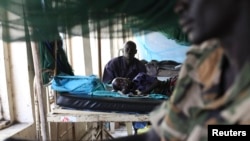Major health, development and financial agencies have unveiled a $100 billion plan to cut global malaria cases and deaths by 90 percent over the next 15 years. The Roll Back Malaria Partnership says its new strategy will result in a health and economic bonanza for developing countries.
The United Nations Millennium Development Goal to halt and begin to reverse the incidence of malaria by 2015 has been met. The Roll Back Malaria Partnership is now gearing up to pursue the more ambitious malaria elimination targets set out in the U.N. Sustainable Development Goals.
The SDGs call for a 90 percent reduction in malaria cases and deaths globally by 2030 and eliminating the disease in 35 countries.
Roll Back Malaria Partnership Executive Director Fatoumata Nafo-Traore calls this an ambitious, but achievable goal. She said it can be done with an investment of $100 billion and universal access to well targeted and proven tools.
Nafo-Traore told VOA the new strategy consists of three major interventions. The first is prevention, which she said involves the widespread use of insecticide-treated bed nets and indoor residual spraying, as well as the optimal use of resources for limiting or eradicating malaria-bearing mosquitoes.
Correctly diagnosing the illness, she said, is the second element.
“The first symptom of malaria is a fever and we are using either microscopy or a rapid diagnostic test that can be used even at the village level by non-health workers … and, if it is positive, then ensuring that [the anti-malarial drug] Artemisinin in combination therapy, which is a highly effective treatment for malaria, is available to take care of the patient,” she said.
Nafo-Traore says the third important element in this strategy is research and development. She said it is critical to have new insecticides and new treatments for malaria available in case of growing resistance to these vital tools.
Great progress has been made in the fight against malaria. The World Health Organization reports a 58 percent reduction in malaria deaths since 2000. It says more than 6.2 million malaria deaths were averted between 2001 and 2015.
WHO Global Malaria Program Director Pedro Alonso said these results are excellent, but more remains to be done.
“We still have over 200 million cases every year of malaria, we have close to 500,000 - half a million - deaths due to malaria, mostly among African children, 60 million malaria cases go undiagnosed and untreated…So, as we celebrate the huge success, we recognize the massive unfinished agenda.”
It will cost more than $100 billion to address this unfinished agenda and achieve the 2030 target of reducing global malaria cases and deaths by 90 percent. Still, the Roll Back Malaria Partnership, which includes organizations such as the WHO, the U.N. Children’s Fund, and the World Bank, consider this a great investment.
They say there will be a $40 return for every dollar invested globally to reduce malaria, and a $60 return for every dollar invested in sub-Saharan Africa. They say there will be a $4 trillion boost to the world economy if the 2030 goal of averting nearly three billion malaria cases and saving more than 10 million lives is achieved.








